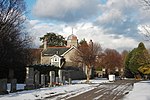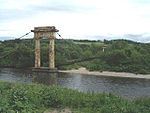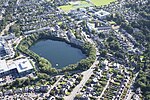Pitfodels railway station
Disused railway stations in AberdeenshireFormer Great North of Scotland Railway stationsPages with no open date in Infobox stationRailway stations in Great Britain closed in 1937Railway stations in Great Britain opened in 1894 ... and 1 more
Use British English from March 2019

Pitfodels railway station or Pitfodels Halt was opened on 2 July 1894 by the GNoSR and served a suburb of Aberdeen with housing and estates such as Wellwood, Inchgarth and Norwood. The halt was one of several victims of the 1937 closure of stations on the Aberdeen suburban service. The Deeside Railway itself ran from Aberdeen (Joint) to Ballater. Pitfodels is located in the parish of Peterculter, Aberdeenshire, Scotland.
Excerpt from the Wikipedia article Pitfodels railway station (License: CC BY-SA 3.0, Authors, Images).Pitfodels railway station
Pitfodels Station Road, Aberdeen City Cults
Geographical coordinates (GPS) Address Nearby Places Show on map
Geographical coordinates (GPS)
| Latitude | Longitude |
|---|---|
| N 57.1205 ° | E -2.1561 ° |
Address
Pitfodels Station Road
Pitfodels Station Road
AB15 9PJ Aberdeen City, Cults
Scotland, United Kingdom
Open on Google Maps









